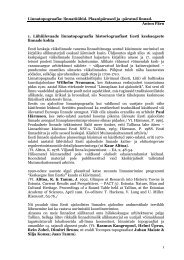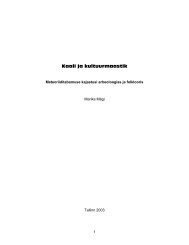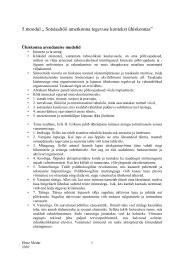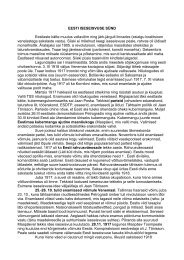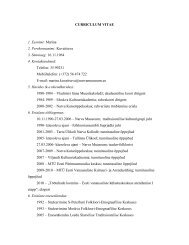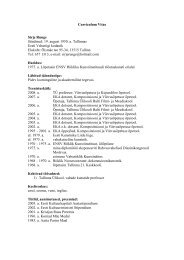crowding and children's mental health: the role of house type
crowding and children's mental health: the role of house type
crowding and children's mental health: the role of house type
Create successful ePaper yourself
Turn your PDF publications into a flip-book with our unique Google optimized e-Paper software.
228 G. W. Evans et al.<br />
interaction results. However, examination <strong>of</strong> <strong>the</strong><br />
£oor level data revealed that 99.5% <strong>of</strong> <strong>the</strong> sample<br />
resided on <strong>the</strong> fourth £oor or lower, thus precluding<br />
an adequate test <strong>of</strong> <strong>the</strong> implications <strong>of</strong> £oor level for<br />
children’s <strong>mental</strong> <strong>health</strong>. Although <strong>the</strong>re is a paucity<br />
<strong>of</strong> data on this topic, <strong>the</strong> housing literature suggests<br />
that living above <strong>the</strong> fourth or ¢fth £oor appears to<br />
be where di⁄culties emerge (Halpern, 1995; Evans et<br />
al., in press; Gi¡ord, in press). Thus ano<strong>the</strong>r important<br />
extension <strong>of</strong> this study would be to stratify a<br />
future sample by £oor level in order to insure that<br />
enough people living at higher £oors were included<br />
in order to tease apart £oor level e¡ects from multiple<br />
dwelling categorization in general.<br />
In addition to <strong>the</strong> interaction ¢ndings, <strong>the</strong> present<br />
data are also <strong>of</strong> some importance for examining<br />
<strong>the</strong> main e¡ects <strong>of</strong> density <strong>and</strong> housing <strong>type</strong>,<br />
respectively, on children’s <strong>mental</strong> <strong>health</strong>. What <strong>the</strong>y<br />
revealin <strong>the</strong> former case is that independent <strong>of</strong><br />
mo<strong>the</strong>r’s educationallevel, as density increases,<br />
modest decrements in children’s psychological<br />
<strong>health</strong> occur. This ¢nding extends prior research<br />
showing that residentialdensity is associated with<br />
family con£ict (Booth & Edwards, 1976; Saegert,<br />
1982; Evans et al., 1998) <strong>and</strong> diminished parentalresponsiveness<br />
to children (Bradley & Caldwell, 1984;<br />
Wachs, 1989; Evans et al., in press). Thus, not only do<br />
family dynamics appear to shift in more crowded<br />
homes, <strong>the</strong>se changes may play a <strong>role</strong> in children’s<br />
<strong>mental</strong><strong>health</strong> as indicated by children <strong>the</strong>mselves<br />
on a well developed, st<strong>and</strong>ardized instrument. We<br />
also replicate three previous studies showing a link<br />
between residentialdensity <strong>and</strong> teachers’ ratings <strong>of</strong><br />
behavioralconduct in <strong>the</strong> classroom (Booth & Johnson,<br />
1975; Saegert, 1982; Evans et al., 1998).Weshow<br />
that <strong>the</strong> latter relation generalizes to a much larger<br />
sample <strong>of</strong> children <strong>and</strong> holds in rural Austria. The<br />
Booth <strong>and</strong> Johnson <strong>and</strong> Saegert studies examined<br />
a wider range <strong>of</strong> ages; all three prior studies were<br />
conducted in urban areas, <strong>and</strong> Evans data are from<br />
India, Saegert’s from public housing in New York<br />
city, <strong>and</strong> Booth <strong>and</strong> Johnson’s from Canada. Thus,<br />
<strong>the</strong> link between density <strong>and</strong> teacher ratings <strong>of</strong> conduct<br />
in <strong>the</strong> classroom appears robust. Clearly more<br />
research, particularly with stronger longitudinal designs<br />
is necessary to bolster our con¢dence in <strong>the</strong><br />
link between <strong>house</strong>hold <strong>crowding</strong> <strong>and</strong> children’s<br />
<strong>mental</strong><strong>health</strong>.<br />
With respect to housing <strong>type</strong>, both measures<br />
show that multiple-family dwellings, independent <strong>of</strong><br />
maternaleducationalbackground, are associated<br />
with poorer <strong>mental</strong><strong>health</strong> in children. Post hoc<br />
tests for both <strong>the</strong> KINDL <strong>and</strong> <strong>the</strong> Needleman scale<br />
indicated no di¡erences between single-family detached<br />
housing <strong>and</strong> row housing. These ¢ndings replicate<br />
previous housing literature (Ineichen &<br />
Hooper, 1974; Richman, 1977; Saegert, 1982), demonstrating<br />
di¡erences in children’s <strong>mental</strong> <strong>health</strong> between<br />
multiple dwelling units <strong>and</strong> single-family<br />
homes. The ¢ndings fur<strong>the</strong>r streng<strong>the</strong>n this literature<br />
in two respects. First, none <strong>of</strong> <strong>the</strong> prior studies<br />
used both self-repot <strong>and</strong> adult ratings <strong>of</strong> <strong>mental</strong><br />
<strong>health</strong>. Second, <strong>the</strong> prior studies focused on younger<br />
children, <strong>and</strong> two <strong>of</strong> <strong>the</strong>m were conducted in o<strong>the</strong>r<br />
countries. Thus our parallel ¢ndings across two indices<br />
<strong>and</strong> with older children in <strong>the</strong> U.S. suggests<br />
<strong>the</strong> link between multiple housing occupancy <strong>and</strong><br />
psychological distress may be broadly applicable to<br />
children. Ano<strong>the</strong>r aspect <strong>of</strong> our data on housing<br />
<strong>type</strong> <strong>and</strong> <strong>mental</strong> <strong>health</strong> is notable. The housing literature<br />
¢nds that high rises in particular are problematic<br />
ra<strong>the</strong>r than multiple dwelling complexes<br />
per se. In <strong>the</strong> present sample, multiple dwelling<br />
units, even at four £oors or less, di¡er from singlefamily<br />
detached <strong>and</strong> row <strong>house</strong>s, raising <strong>the</strong> question<br />
<strong>of</strong> whe<strong>the</strong>r <strong>the</strong> important design variable is<br />
£oor level as <strong>the</strong> housing <strong>and</strong> <strong>mental</strong> <strong>health</strong> literature<br />
has suggested. Since prior studies <strong>of</strong> £oor level<br />
confound building scale with height, this issue warrants<br />
fur<strong>the</strong>r investigation. Clearly, it would also be<br />
valuable to study <strong>crowding</strong>, housing features <strong>and</strong><br />
children’s <strong>mental</strong> <strong>health</strong> with a stronger research<br />
design, ideally incorporating r<strong>and</strong>om assignment to<br />
housing conditions or, more realistically, prospective<br />
longitudinal designs. Currently, <strong>the</strong> little data<br />
available on children’s <strong>mental</strong> <strong>health</strong> in relation to<br />
ei<strong>the</strong>r residentialdensity or housing quality emanate<br />
from cross-sectionalstudies.<br />
The <strong>role</strong> <strong>of</strong> <strong>the</strong> physical environment, including<br />
<strong>house</strong> <strong>type</strong> in altering human^environment relations<br />
has not received adequate attention. Just as<br />
personal(e.g. temperament) or social(e.g. social<br />
support) resources can alter <strong>the</strong> ¢t between people<br />
<strong>and</strong> <strong>the</strong>ir surroundings, so too can <strong>the</strong> physicalenvironment<br />
serve as a moderator that can exacerbate<br />
or bu¡er human responses to <strong>the</strong> environment<br />
(Becker, 1990; Evans & Lepore, 1997). Herein we demonstrate<br />
that <strong>the</strong> <strong>mental</strong> <strong>health</strong> sequelae <strong>of</strong> residential<strong>crowding</strong><br />
among children are changed by<br />
<strong>the</strong> <strong>type</strong> <strong>of</strong> housing <strong>the</strong>y inhabit. The harmfulpsychological<br />
correlates <strong>of</strong> density among elementary<br />
schoolchildren are accentuated by residing in multiple<br />
dwelling units. This interaction manifests in<br />
both children’s self-reports <strong>and</strong> in independent teacher<br />
ratings <strong>of</strong> behavioralproblems in <strong>the</strong> classroom.<br />
We speculate that multiple dwelling units make it<br />
more di⁄cult for children <strong>and</strong> <strong>the</strong>ir families to


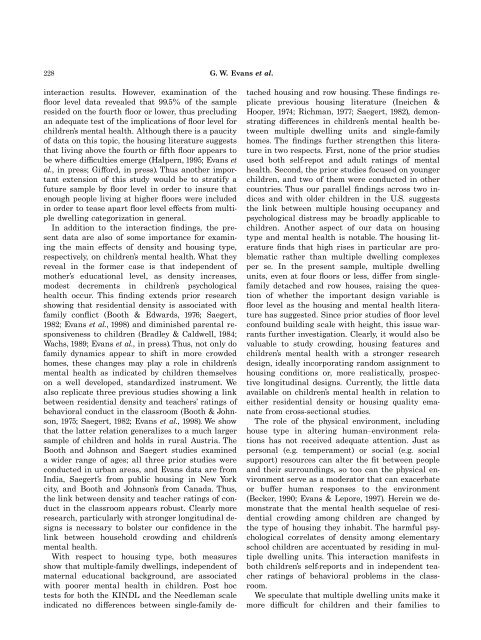
![5 Verben 2 S[1]. 35-44.pdf](https://img.yumpu.com/27096544/1/184x260/5-verben-2-s1-35-44pdf.jpg?quality=85)

